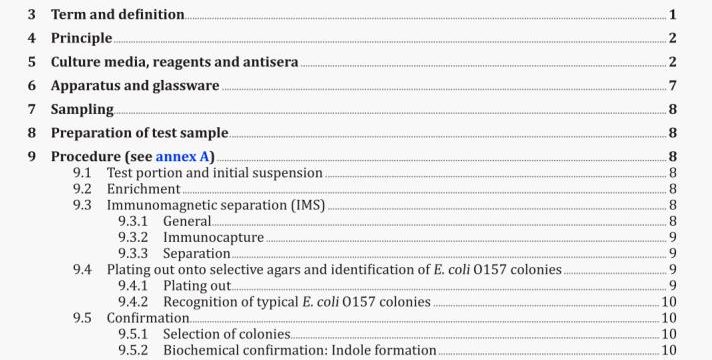Microbiology of food and animal feeding stuffs — Horizontal method for the detection of Escherichia coil 0157
AS 5013.26-2020 pdf download.Food microbiology
Method 26: Microbiology of food and animal feeding stuffs — Horizontal method for the detection of Escherichia coil 0157.
In general, to prepare the initial suspension, add a test portion of x g or x ml to 9x ml or 9x g of modified tryptone soya broth with novobiocin (rnTSB + N) (&Jj, pre-warmed in the incubator (6) to 41,5 °C to obtain a ratio of test portion to mTSB + N of 1/10 (mass to volume, or volume to volume).
It is recommended to use stomacher bags with mesh inserts to reduce the interference of food particles with immunocapture kits (.3).
9.2 Enrichment
Incubate (fA) the initial suspension, prepared in accordance with 9d. at 41,5°C for 6 h, and subsequently for a further 12 h to 18 h (i.e. to a total elapsed time of 18 h to 24 h).
A 6-li incubation followed by immunomagnetic separation and plating onto selective agars can yield a presumptive positive result which can become negative after a further 18-h incubation.
9.3 Immunomagnetic separation (IMS)
9.3.1 General
IMS should be carried out after 6 hand again, if necessary, after 12 h to 18 h of incubation.
The Instructions below are tor general guidance and may not be complete in all details. Therefore the manufacturer’s instructions should be followed concerning the procedure and method for the use of immunocapture kits and the equipment needed.
9.3.2 Immunocapture
WARNING — Use aseptic techniques to avoid any external contamination and the creation of aerosols. Perform this protocol in a containment safety cabinet, if available. Wear gloves.
Using the magnetic separator (6.12) and antibody-coated immunomagnetic particles (5.7), carry out the following capture/separation procedure.
Mix the enrichment culture (9.2) and allow any coarse food materials to settle out. To an Eppendorftype plastic tube (6.13), add 20 p1 of the prepared immunornagnetic particles (5.7) at room temperature. Take 1 ml of the upper liquid from the enrichment culture, avoiding if possible the transfer of any food particles or fatty materials, and transfer to the Eppendorf-type plastic tube.
Mix the suspension on the rotary mixer (6.14) set at about 12 r/min to 20 r/min for 10 mm.
9.3.3 Separation
Place each Eppendorf-type plastic tube (see 9.3.2) in the magnetic rack (6.12) and allow the magnetic particles to congregate against the magnet by gently rocking the rack through 180°. Open the cap carefully without disturbing the particles on the wall of the tube. Using a new sterile Pasteur pipette (6.10) for each sample and with the tube still in the magnetic rack, remove the liquid by sucking slowly from the bottom of the tube. Add 1 ml of sterile wash buffer (5.8) and replace the cap. Remove the magnet from the rack. Mix the contents of the tubes by gentle inversion of the rack through 1800 and then return the magnet to the rack.
Take care to avoid cross contamination when adding fresh buffer.
Proceed as above to remove the wash liquid with a new Pasteur pipette for each sample. Repeat the washing procedure several times.
Remove from the magnetic separator and add 100 p1 of sterile wash buffer (5.8) to the tube and resuspend the magnetic particles.
NOTE This procedure could be difficult to apply to fat products or fresh cheese.
9.4 Plating out onto selective agars and identification of E. coil 0157 colonies
9.4.1 Plating out
Using a mechanical-type pipettor (6.11), transfer 50 p1 of the washed and re-suspended magnetic particles (9.3.3) to a pre-dried plate of cefixime tellurite sorbitol MacConkey agar (5.2) and also 50 p1 to a pre-dried plate of the second isolation medium (5.3).
Streak out the particles using a sterile loop (6.10) to obtain many well-isolated colonies over the agar.
Incubate (6.3) the CT-SMAC (5.2) at 37 °C for 18 h to 24 h, and incubate the second selective agar at its recommended temperature and specified time.
Depending on the type of food sample and its microbial flora, incubation of the enrichment broth for 20 h to 24 h may give rise to a heavy growth of other bacteria on the selective agar plates so that colonies of E. coil 0157 are difficult to find. Inoculation of selective agars with dilutions of the IMS preparation or volumes less than 50 p1 per plate can increase the chance of gaining separated colonies of E, coil 0157 but note that this can increase the detection limit as well.AS 5013.26-2020 pdf download.
Microbiology of food and animal feeding stuffs — Horizontal method for the detection of Escherichia coil 0157
